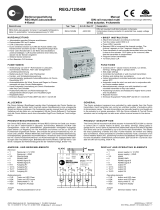Page is loading ...

FTS14 communication interface for the
Eltako RS485 bus with enclosed power
supply FSNT14-12V/12W. Only 0.4 watt
standby loss.
Modular device for DIN-EN 60715 TH35 rail
mounting. 1 module = 18 mm wide, 58 mm
deep.
Supply voltage 12 V DC.
Connection to the Eltako RS485 bus.
Bus wiring and power supply with jumpers.
The delivery includes 1 power supply
FSNT14-12V/12W, 1 spacer DS14, 2 terminators
with printing Ω, 1/2 module, 3 jumpers 1 module
(including 1 spare), 1 jumper 1,5 TE, 2 jumpers
1/2 module (including 1 spare) and 1 jumper
installation tool SMW14.
If the power supply is subjected to a load
of more than 4 W, a ventilation distance of
½ to neighboring devices must be main-
tained on the left side. With a load greater
than 6 W, a ½ ventilation gap is also required
between the FSNT14 and the FAM14 with
the DS14 spacer.
A DS14 spacer and a long jumper are there-
fore included. If the total power requirement
of a series 14 bus system is higher than 10 W,
an additional FSNT14-12V/12W must be used
for every 12 W of additional power.
Optionally, 12 V DC can also be supplied at
the GND/+12 V terminals.
Connection to the Eltako-RS485 bus. Bus
ii i j
FTS14 communication interface
FTS14KS
GB
Temperature at mounting location:
-20°C up to +50°C.
Storage temperature: -25°C up to +70°C.
Relative humidity:
annual average value <75%.
30 014 065 - 2
Only skilled electricians may install this
electrical equipment otherwise there is
the risk of re or electric shock!
valid for devices from production week
07/22 (see bottom side of housing)
cross wiring and power supply with jumper.
The attached second terminator should be
plugged to the last actuator.
Mini USB to connect to a PC, to create an
equipment list, to con gurate the actuators
using the PC tool PCT14 and for data backup.
All FTS14EM and if needed gateways FGW14
will be connected to the terminal Hold when
they connect a PC with a RS232 bus.
According to the operating manual 10 different
operating modes can be set with the operating
mode rotary switch BA.
Mode switch
When the rotary switch is set to position 1,
a bus scan can be performed. Then addresses
(1..126) for new actuators will be assigned
which were successively set to LRN. The
bottom LED ashes red, when an address was
assigned the LED ashes green for 5 seconds.
When the rotary switch is set to position 2
or after switching on the supply voltage, a bus
scan is performed and a scan list is created.
Then con rmation telegrams of actuators are
cyclically scanned by scan list. The bottom
LED ashes red and lights up green for a
short period if a telegram was sent.
After the rotary switch is turned to position 3
or after the supply voltage is applied, a bus
scan is performed and a scan list is created.
Then con rmation telegrams of actuators are
cyclically scanned by scan list. The bottom
LED ashes red.
Pos. 4: function like position 3 but also status
telegrams of the actuators are requested.
Pos. 5: con rmation telegrams of actuators
are cyclically scanned by the device list that
was created in the PC tool PCT14. The lower
LED brie y lights up green when a con rmation
telegram has been received.
Pos. 6: con rmation telegrams of actuators
are cyclically scanned by the device list that
was created in the PC tool PCT14.
Pos. 7: function like position 6 but also status
telegrams of the actuators are requested.
Pos. 8: Unidirectional, not suitable for
operation with FSU14 or FGSM14.
Pos. 9: teaching-in wireless timer FSU14 in
wireless actuators. Reading and writing of
the base ID of FTS14KS with PC tool PCT14.
Pos. 10: teaching-in of the wireless timer
FSU14 into bus actuators. Control master
operation with PC-Tool PCT14. The lower
LED ashes green and ickers during bus
operation.
The bottom LED lights up green if a connection
from the PC tool PCT14 was created. When
reading or writing date the LED ashes green.
The green LED goes out if the connection
from the PC tool PCT14 was terminated.
Assign device address for actuators:
The rotary switch on the FTS14KS is set to
position 1, its lower LED ashes red.
The rotary switch of the rst actuator is set
to LRN, the LED on the actuator ashes
smoothly.
After the address of the FTS14KS was assigned
,
its lower LED ashes green for 5 seconds
and the LED of the actuator goes out. Then
set the second actuator to LRN etc.
Caution! The bottom rotary switch of the
FSR14.. has to be on one channel.
Con gurate FTS14KS:
The following points can be con gured with
the PC tool PCT14:
ɀ create device list
CAUTION! Don’t forget 'disconnect FTS14KS'
in the PC tool PCT14. While the connection
from the PC tool PCT14 to the FTS14KS
exists, no wireless commands are executed.

Typical connection
The enclosed second terminator of the
FTS14KS must be plugged to the last actuator.
Attention!
Follow exactly this installation
procedure:
1. Place all devices on the DIN rail.
2. Fasten the devices right and left with end
clamps for DIN rail.
3. Connect all cables and wires.
4. Insert the jumpers, to do that, place the
jumper into the tool SMW14 and connect it
on the devices.
For connecting or removing the jumpers,
only use the jumper installation tool
SMW14 and move vertically to the DIN rail.
!
Must be kept for later use!
We recommend the housing for
operating instructions GBA14.
Eltako GmbH
D-70736 Fellbach
Technical Support English:
+49 711 94350025
technical-support@eltako.de
eltako.com
34/2022 Subject to change without notice.
Manuals and documents in further
languages
http://eltako.com/redirect/FTS14KS
1. App 2. 3.
www.
/

